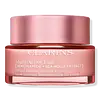What's inside
What's inside
 Key Ingredients
Key Ingredients

 Benefits
Benefits

 Concerns
Concerns

 Ingredients Side-by-side
Ingredients Side-by-side

Water
Skin ConditioningGlycerin
HumectantDimethicone
EmollientIsopropyl Isostearate
EmollientDipropylene Glycol
HumectantSqualane
EmollientPEG/PPG-18/18 Dimethicone
EmulsifyingSilica
AbrasiveTocopheryl Acetate
AntioxidantSodium Hyaluronate
HumectantOlea Europaea Fruit Extract
BleachingCentella Asiatica Extract
CleansingAloe Barbadensis Leaf Water
MaskingPalmitoyl Hexapeptide-12
Skin ConditioningTriticum Vulgare Bran Extract
Skin ConditioningCaffeine
Skin ConditioningMethyl Trimethicone
Skin ConditioningSorbitol
HumectantSodium Polyaspartate
HumectantPetrolatum
EmollientTrehalose
HumectantLactis Proteinum
Skin ConditioningLinoleic Acid
CleansingPyridoxine Dipalmitate
Skin ConditioningButylene Glycol
HumectantCholesterol
EmollientSucrose
HumectantPolysilicone-11
Glyceryl Polymethacrylate
PEG-150
HumectantPEG-8
HumectantHydroxyethyl Urea
HumectantHydroxyacetophenone
AntioxidantBHT
AntioxidantDisodium EDTA
Sodium Hexametaphosphate
MaskingSodium Benzoate
MaskingPotassium Sorbate
PreservativePhenoxyethanol
PreservativeWater, Glycerin, Dimethicone, Isopropyl Isostearate, Dipropylene Glycol, Squalane, PEG/PPG-18/18 Dimethicone, Silica, Tocopheryl Acetate, Sodium Hyaluronate, Olea Europaea Fruit Extract, Centella Asiatica Extract, Aloe Barbadensis Leaf Water, Palmitoyl Hexapeptide-12, Triticum Vulgare Bran Extract, Caffeine, Methyl Trimethicone, Sorbitol, Sodium Polyaspartate, Petrolatum, Trehalose, Lactis Proteinum, Linoleic Acid, Pyridoxine Dipalmitate, Butylene Glycol, Cholesterol, Sucrose, Polysilicone-11, Glyceryl Polymethacrylate, PEG-150, PEG-8, Hydroxyethyl Urea, Hydroxyacetophenone, BHT, Disodium EDTA, Sodium Hexametaphosphate, Sodium Benzoate, Potassium Sorbate, Phenoxyethanol
Water
Skin ConditioningCaprylic/Capric Triglyceride
MaskingBetaine
HumectantPropanediol
SolventDicaprylyl Carbonate
EmollientCetearyl Alcohol
EmollientHydrogenated Coco-Glycerides
EmollientNiacinamide
SmoothingPrunus Armeniaca Kernel Oil
MaskingGlycerin
HumectantGlyceryl Stearate
EmollientPEG-100 Stearate
Cetearyl Glucoside
EmulsifyingHydroxyethyl Acrylate/Sodium Acryloyldimethyl Taurate Copolymer
Emulsion StabilisingPropylene Glycol
HumectantDimethicone
EmollientParfum
MaskingSteareth-21
CleansingCaprylyl Glycol
EmollientCellulose
AbsorbentMica
Cosmetic ColorantCI 77891
Cosmetic ColorantEthylhexylglycerin
Skin ConditioningTocopheryl Acetate
AntioxidantDisodium EDTA
Potassium Sorbate
PreservativePolysorbate 60
EmulsifyingSorbitan Isostearate
EmulsifyingButylene Glycol
HumectantCitric Acid
BufferingEryngium Maritimum Extract
TonicMarrubium Vulgare Extract
Skin ConditioningDipsacus Sylvestris Extract
Skin ConditioningPhenethyl Alcohol
MaskingFurcellaria Lumbricalis Extract
Skin ConditioningSodium Citrate
BufferingArbutus Unedo Fruit Extract
AntioxidantTocopherol
AntioxidantLapsana Communis Flower/Leaf/Stem Extract
Skin ConditioningMaris Sal
Skin ConditioningCI 17200
Cosmetic ColorantWater, Caprylic/Capric Triglyceride, Betaine, Propanediol, Dicaprylyl Carbonate, Cetearyl Alcohol, Hydrogenated Coco-Glycerides, Niacinamide, Prunus Armeniaca Kernel Oil, Glycerin, Glyceryl Stearate, PEG-100 Stearate, Cetearyl Glucoside, Hydroxyethyl Acrylate/Sodium Acryloyldimethyl Taurate Copolymer, Propylene Glycol, Dimethicone, Parfum, Steareth-21, Caprylyl Glycol, Cellulose, Mica, CI 77891, Ethylhexylglycerin, Tocopheryl Acetate, Disodium EDTA, Potassium Sorbate, Polysorbate 60, Sorbitan Isostearate, Butylene Glycol, Citric Acid, Eryngium Maritimum Extract, Marrubium Vulgare Extract, Dipsacus Sylvestris Extract, Phenethyl Alcohol, Furcellaria Lumbricalis Extract, Sodium Citrate, Arbutus Unedo Fruit Extract, Tocopherol, Lapsana Communis Flower/Leaf/Stem Extract, Maris Sal, CI 17200
 Reviews
Reviews

Ingredients Explained
These ingredients are found in both products.
Ingredients higher up in an ingredient list are typically present in a larger amount.
Butylene Glycol (or BG) is used within cosmetic products for a few different reasons:
Overall, Butylene Glycol is a safe and well-rounded ingredient that works well with other ingredients.
Though this ingredient works well with most skin types, some people with sensitive skin may experience a reaction such as allergic rashes, closed comedones, or itchiness.
Learn more about Butylene GlycolDimethicone is a type of synthetic silicone created from natural materials such as quartz.
What it does:
Dimethicone comes in different viscosities:
Depending on the viscosity, dimethicone has different properties.
Ingredients lists don't always show which type is used, so we recommend reaching out to the brand if you have questions about the viscosity.
This ingredient is unlikely to cause irritation because it does not get absorbed into skin. However, people with silicone allergies should be careful about using this ingredient.
Note: Dimethicone may contribute to pilling. This is because it is not oil or water soluble, so pilling may occur when layered with products. When mixed with heavy oils in a formula, the outcome is also quite greasy.
Learn more about DimethiconeDisodium EDTA plays a role in making products more stable by aiding other preservatives.
It is a chelating agent, meaning it neutralizes metal ions that may be found in a product.
Disodium EDTA is a salt of edetic acid and is found to be safe in cosmetic ingredients.
Learn more about Disodium EDTAGlycerin is already naturally found in your skin. It helps moisturize and protect your skin.
A study from 2016 found glycerin to be more effective as a humectant than AHAs and hyaluronic acid.
As a humectant, it helps the skin stay hydrated by pulling moisture to your skin. The low molecular weight of glycerin allows it to pull moisture into the deeper layers of your skin.
Hydrated skin improves your skin barrier; Your skin barrier helps protect against irritants and bacteria.
Glycerin has also been found to have antimicrobial and antiviral properties. Due to these properties, glycerin is often used in wound and burn treatments.
In cosmetics, glycerin is usually derived from plants such as soybean or palm. However, it can also be sourced from animals, such as tallow or animal fat.
This ingredient is organic, colorless, odorless, and non-toxic.
Glycerin is the name for this ingredient in American English. British English uses Glycerol/Glycerine.
Learn more about GlycerinPotassium Sorbate is a preservative used to prevent yeast and mold in products. It is commonly found in both cosmetic and food products.
This ingredient comes from potassium salt derived from sorbic acid. Sorbic acid is a natural antibiotic and effective against fungus.
Both potassium sorbate and sorbic acid can be found in baked goods, cheeses, dried meats, dried fruit, ice cream, pickles, wine, yogurt, and more.
You'll often find this ingredient used with other preservatives.
Learn more about Potassium SorbateTocopheryl Acetate is AKA Vitamin E. It is an antioxidant and protects your skin from free radicals. Free radicals damage the skin by breaking down collagen.
One study found using Tocopheryl Acetate with Vitamin C decreased the number of sunburned cells.
Tocopheryl Acetate is commonly found in both skincare and dietary supplements.
Learn more about Tocopheryl AcetateWater. It's the most common cosmetic ingredient of all. You'll usually see it at the top of ingredient lists, meaning that it makes up the largest part of the product.
So why is it so popular? Water most often acts as a solvent - this means that it helps dissolve other ingredients into the formulation.
You'll also recognize water as that liquid we all need to stay alive. If you see this, drink a glass of water. Stay hydrated!
Learn more about Water